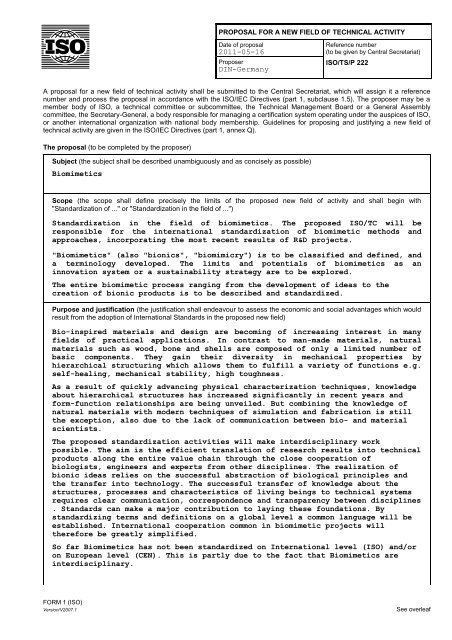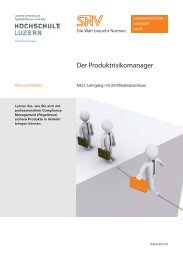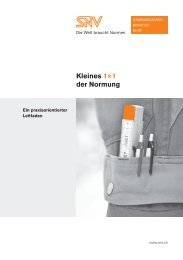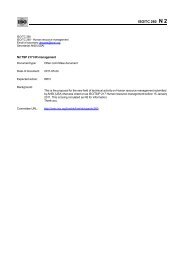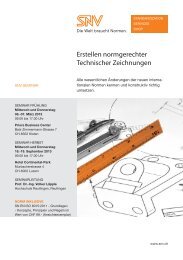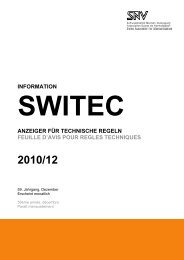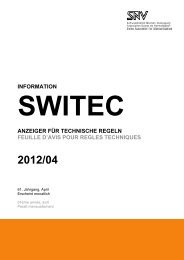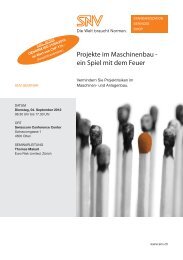ISO/TS/P 222 Biomimetics - SNV
ISO/TS/P 222 Biomimetics - SNV
ISO/TS/P 222 Biomimetics - SNV
You also want an ePaper? Increase the reach of your titles
YUMPU automatically turns print PDFs into web optimized ePapers that Google loves.
PROPOSAL FOR A NEW FIELD OF TECHNICAL ACTIVITY<br />
Date of proposal<br />
2011-05-16<br />
Proposer<br />
DIN-Germany<br />
Reference number<br />
(to be given by Central Secretariat)<br />
<strong>ISO</strong>/<strong>TS</strong>/P <strong>222</strong><br />
A proposal for a new field of technical activity shall be submitted to the Central Secretariat, which will assign it a reference<br />
number and process the proposal in accordance with the <strong>ISO</strong>/IEC Directives (part 1, subclause 1.5). The proposer may be a<br />
member body of <strong>ISO</strong>, a technical committee or subcommittee, the Technical Management Board or a General Assembly<br />
committee, the Secretary-General, a body responsible for managing a certification system operating under the auspices of <strong>ISO</strong>,<br />
or another international organization with national body membership. Guidelines for proposing and justifying a new field of<br />
technical activity are given in the <strong>ISO</strong>/IEC Directives (part 1, annex Q).<br />
The proposal (to be completed by the proposer)<br />
Subject (the subject shall be described unambiguously and as concisely as possible)<br />
<strong>Biomimetics</strong><br />
Scope (the scope shall define precisely the limits of the proposed new field of activity and shall begin with<br />
"Standardization of ..." or "Standardization in the field of ...")<br />
Standardization in the field of biomimetics. The proposed <strong>ISO</strong>/TC will be<br />
responsible for the international standardization of biomimetic methods and<br />
approaches, incorporating the most recent results of R&D projects.<br />
"<strong>Biomimetics</strong>" (also "bionics", "biomimicry") is to be classified and defined, and<br />
a terminology developed. The limits and potentials of biomimetics as an<br />
innovation system or a sustainability strategy are to be explored.<br />
The entire biomimetic process ranging from the development of ideas to the<br />
creation of bionic products is to be described and standardized.<br />
Purpose and justification (the justification shall endeavour to assess the economic and social advantages which would<br />
result from the adoption of International Standards in the proposed new field)<br />
Bio-inspired materials and design are becoming of increasing interest in many<br />
fields of practical applications. In contrast to man-made materials, natural<br />
materials such as wood, bone and shells are composed of only a limited number of<br />
basic components. They gain their diversity in mechanical properties by<br />
hierarchical structuring which allows them to fulfill a variety of functions e.g.<br />
self-healing, mechanical stability, high toughness.<br />
As a result of quickly advancing physical characterization techniques, knowledge<br />
about hierarchical structures has increased significantly in recent years and<br />
form-function relationships are being unveiled. But combining the knowledge of<br />
natural materials with modern techniques of simulation and fabrication is still<br />
the exception, also due to the lack of communication between bio- and material<br />
scientists.<br />
The proposed standardization activities will make interdisciplinary work<br />
possible. The aim is the efficient translation of research results into technical<br />
products along the entire value chain through the close cooperation of<br />
biologists, engineers and experts from other disciplines. The realization of<br />
bionic ideas relies on the successful abstraction of biological principles and<br />
the transfer into technology. The successful transfer of knowledge about the<br />
structures, processes and characteristics of living beings to technical systems<br />
requires clear communication, correspondence and transparency between disciplines<br />
. Standards can make a major contribution to laying these foundations. By<br />
standardizing terms and definitions on a global level a common language will be<br />
established. International cooperation common in biomimetic projects will<br />
therefore be greatly simplified.<br />
So far <strong>Biomimetics</strong> has not been standardized on International level (<strong>ISO</strong>) and/or<br />
on European level (CEN). This is partly due to the fact that <strong>Biomimetics</strong> are<br />
interdisciplinary.<br />
FORM 1 (<strong>ISO</strong>)<br />
Version/V2007.1<br />
See overleaf


